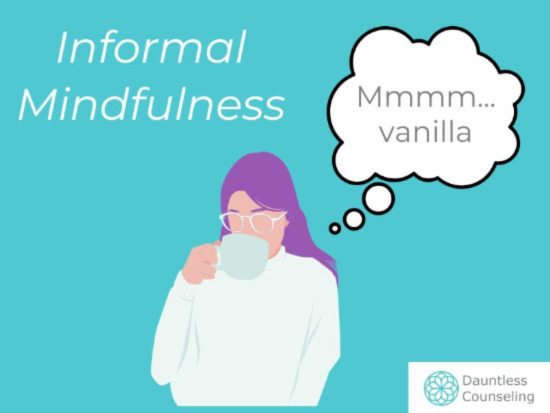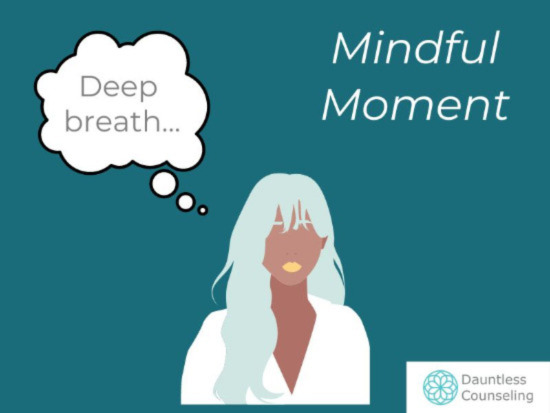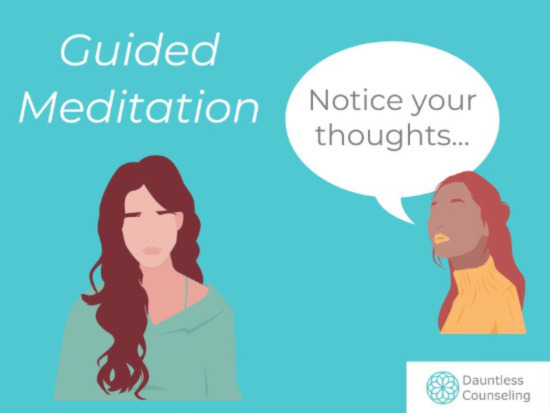Mindfulness is a powerful tool that can improve focus, reduce anxiety and depression, and improve your sleep (among other things!) when practiced regularly. (You can check out the research on the UCLA website if you’re curious.)
So let’s talk about mindfulness!
Table of Contents
Mindfulness Defined
In short, mindfulness is intentionally being present in the moment while also staying curious.
As humans, our minds will naturally wander to the past or the future. The problem with this is that anxiety tends to live in the future (i.e., “What if ______ happens?”) and depression tends to live in the past (i.e., “If only ______ had/hadn’t happened.”).
Although there is nothing wrong with reminiscing about the past or daydreaming about plans for the future, it can be easy to get caught up in less helpful trains of thought that take you away from the present moment.
The staying curious part is equally important because as humans we also tend towards judgement rather than curiosity. And judging the moment tends to take us out of the moment. Staying curious is being open to whatever you notice about the moment that you’re in and not labeling it as good, bad, or otherwise.
While fairly simple in concept, learning to be more present can take a lot of practice.
If you would like to know more, you can also check out this handout on what mindfulness is not.

Different Kinds of Mindfulness
Many people hear the word “mindfulness” and think of some guy sitting cross-legged up on a mountain top with his eyes closed. While he might be a great example of one way to practice mindfulness, there are actually many ways you practice mindfulness.
You can think of mindfulness like exercise. It’s good for your brain, the same way that exercise is good for your body.
But you’re probably not gonna like every type of mindfulness, just like most people don’t like every kind of physical activity.
Personally, I am not a fan of running. It’s probably one of the last things that I would want to do. But I do enjoy softball and yoga.
It’s the same with mindfulness, you may not like some ways of practicing, but find that others are more your speed.
So here’s a breakdown of some of the different ways you could try being mindful.
Informal Mindfulness
Informal mindfulness involves practicing being present with whatever task or activity you are already doing.
This might look like noticing the smell of your toothpaste as you brush your teeth or paying attention to the feel of the fabric as you fold your laundry.
Informal mindfulness can be easier to try with tasks that are more engaging, such as dancing or painting. It can also be helpful to practice during conversations that are important to you.

Mindful Moments
Mindful moments are a quick pause from whatever activity you were doing to help bring yourself back to the moment.
This might look like stopping to take a slow, deep breath and notice how that feels in your body.
Or you might take a short break to ground yourself by looking around the room and focusing on all the green things (or fuzzy things, or shiny things…) you can find.
Mindful breaks are a quick, easy strategy that can help you “reset” yourself.

Guided Meditation
Most people are more familiar with guided mediation as a form of practicing mindfulness. Guided meditation usually involves listening to some sort of audio (or another person) speaking about a specific topic that they then focus on.
Guided meditation comes in many different “flavors,” including:
- Breathwork (focusing primarily on your breath)
- Bodywork (focusing primarily on what you notice within your own body)
- Movement meditations (incorporating mindfulness while moving)
- Focusing on a specific topic (such as resilience, spirituality, compassion, letting go of thoughts, etc.)
Guided meditations take a bit more intentionality, as you have to set aside at least a few minutes to focus on the meditation to really get the benefits.

Unguided Meditation
Unguided mediation is often considered the most challenging form of mindfulness meditation.
In unguided meditation you simply set aside time to be still and focus on whatever is going on for you internally, either in your body or in your mind. (This is probably what that guy sitting on top of the mountain was doing.)
It often takes time to work up to unguided meditation by practicing the other forms of mindfulness first.

Is Mindfulness for You?
I often encourage my own clients to try different kinds of mindfulness before deciding whether or not mindfulness is for them. Just like you might love playing basketball but hate working out at the gym, you might find some kinds of mindfulness resonate for you while others don’t.
That said, for some people mindfulness is just not their cup of tea, and that’s totally okay. There are plenty of other ways to focus on your mental wellness.

I hope that this article has been helpful for anyone who has been curious about mindfulness and the different ways you can practice mindfulness. Let me know what mindfulness techniques are your favorites in the comments.
As a reminder, this blog post is not intended as professional counseling or clinical advice. This article is meant to provide you with some helpful information about mindfulness as a mental health practice. If you are struggling with your mental health, I encourage you to consider reaching out for additional support, professional or otherwise.

-Kristel Roper, LMFT, LPCC
Kristel Roper is a licensed psychotherapist offering therapy services to individuals in the Sacramento area. She specializes in therapy for anxiety and OCD and especially enjoys working with young adults as they navigate the challenges of college, career, and beyond. Learn more about Kristel Roper’s Therapy Services.
Photo by Darwis Alwan from Pexels

Enjoyed looking at this, very good stuff, thanks.